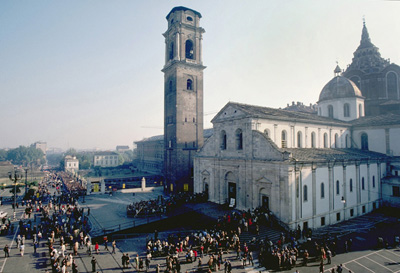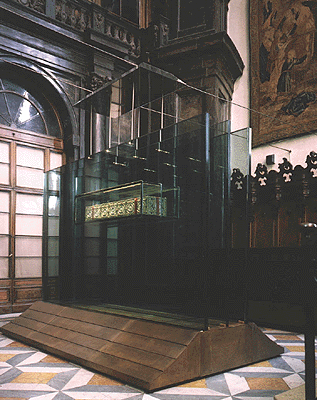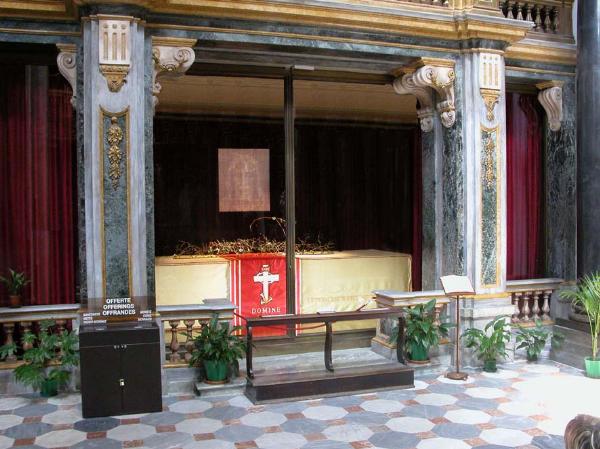© Stephen E. Jones
Locations of the Shroud: Turin 1918-Present
This is the entry, "Locations of the Shroud: Turin 1918-Present," in my Turin Shroud Encyclopedia. It is a continuation from Locations of the Shroud: "Lirey c.1355-Chambéry 1471," "Chambéry 1471-Turin 1578," "Turin 1578-1694" and "Turin 1694-1918." I am working through the topics in the entry, "Shroud of Turin, expanding on them.
[Index] [Previous: Turin 1694-1918] [Next: Image of a man]
Introduction. This is the fifth of a five-part series of entries which has briefly traced the locations of the cloth today known as Shroud of Turin, from its first appearance in undisputed history (see previous) at Lirey, France in c.1355, to its current location since 1578 (apart from short periods due to wars) in or around St John the Baptist Cathedral, Turin, Italy. It is partly based on my 2012 post, "The Shroud's location."
Turin 1918-39. In 1926 Queen Margherita of Savoy (1851–1926), the wife of the late King Umberto I (1844-1900) and mother of King Victor Emmanuel III (1869–1947), died. In 1930 Prince Umberto II (1904–83) married Princess Marie José of Belgium (1906–2001). An
[Above (enlarge): A poster advertising the exposition of the Shroud from 4-24 May, 1931[1].]
exposition of the Shroud was held in Turin Cathedral 1931 to mark that occasion. A local professional photographer Giuseppe Enrie (1886-1961) was appointed to photograph the Shroud. Enrie took a series of black-and-white photographs of the Shroud. But unlike
[Above (enlarge): Sepia print of Enrie's 1931 photograph of the Shroud on the steps of Turin cathedral[2].]
Secondo Pia (1855–1941), Enrie was permitted to photograph the Shroud directly, not through protective glass. Enrie's photographs confirmed Pia's 1898 discovery that the Shroud image is a photographic negative, much to the relief of Pia, who aged 76 was among those present and had been accused in 1898 by Shroud anti-authenticists of photographic error, trickery and even fraud.
Only ~2 years later Pope Pius XI (1857–1939), who as a young priest Achille Ratti was one of Paul Vignon's Alpine mountaineering companions, and first saw the Shroud at the 1898 exposition, decreed that 1933 was a Holy Year, to commemorate 19 centuries since Jesus' death and resurrection[3]. To mark that occasion the Shroud was
[Above (enlarge): The Shroud again displayed above Turin Cathedral's high altar at the 1933 exposition[4].]
exhibited again. Among those who viewed at that exposition for the first time was the French surgeon Dr Pierre Barbet (1884–1961) and a young seminarian Peter Rinaldi (1910-93). In 1937 Umberto II and Marie José's second of four children and only son, Victor Emmanuel (1937-), was born.
Montevergine 1939-46. Due to the outbreak of World War II, and fears that Hitler wanted the Shroud, in September 1939 King Victor Immanuel III secretly moved the Shroud via the Savoy Royal Palace in Rome, to the Benedictine monastery at Montevergine, near Avellino, in south-western Italy.
[Right (enlarge): The Benedictine monastery at Montevergine where the Shroud was secretly kept from September 1939 to October 1946[5].]
There the Shroud remained for ~7 years until the end of the war in 1946. In recognition of the monks preservation of the secrecy of the Shroud's location, the Archbishop of Turin, Cardinal Maurilio Fossati (1876–1965), when he came in October 1946 to collect the Shroud to take it back to Turin, gave the monks their own private exposition of the Cloth!
Turin 1946-83. Due to a proposed referendum to abolish the monarchy and Italy to become a republic, the unpopular King Victor Immanuel III abdicated in 1946 in favour of his son Umberto II who had been effectively king since 1944. The referendum passed and all Savoy property in Italy, including the Royal Chapel which housed the Shroud, and even the Shroud itself, was expropriated by the Italian government. Umberto II, having been formally King of Italy for only 34 days, went with his family into exile in Cascais, Portugal. Ex-king Victor Immanuel III had already left Italy before the referendum and died in 1947 in Alexandria, Egypt. In 1969 a secret Turin Commission examined the Shroud, and again in 1973 openly, but the results were inconclusive. The latter 1973 examination was in conjunction with a 1973 television-only exposition of the Shroud. An exposition of the Shroud was held in 1978 to commemorate the fourth centenary of Turin’s custody of the Cloth. 
[Left (enlarge): "Turin's Cathedral of St. John the Baptist during the 1978 exhibition"[6].]
Immediately after the 1978 exposition a team of USA scientists, the Shroud of Turin Research Project (STURP), carried out an intensive 5-day examination of the Shroud. STURP concluded: 1) the Shroud was not a painting as "no pigments, paints, dyes or stains have been found on the fibrils," that constitutes the image, "It is not the product of an artist," so Bishop d'Arcis' 1389 claim that the Shroud was "cunningly painted" was false; 2) "the image has unique, three-dimensional information encoded in it"; 3) "the image was produced by something which resulted in oxidation, dehydration and conjugation of the polysaccharide structure of the microfibrils of the linen itself"; 4) science cannot explain the image naturalistically, "there are no chemical or physical methods known which can account for the totality of the image, nor can any combination of physical, chemical, biological or medical circumstances explain the image adequately"; and 5) "The blood stains are" real blood, being "composed of hemoglobin and also give a positive test for serum albumin." In 1983 ex-king Umberto II died and, having disinherited his son, Victor Emmanuel for marrying against his wishes, in his will he left the Shroud, which in exile he continued to claim was his private property, to "the Pope and his successors" as its owner, with the Archbishop of Turin the Cloth's custodian, meaning that the Shroud must continue to stay in Turin.
Turin 1983-90. In 1988 the Shroud was radiocarbon dated by three laboratories in Arizona, Zurich and Oxford, all using the same then new Accelerator Mass Spectroscopy (AMS) method. The very first run of the first laboratory to date the Shroud, Arizona, returned the date "1350 AD," which was uncritically accepted by all those present. That "1350 AD" date was leaked to the media by a Rev. David Sox while the carbon dating was still in progress at the other two laboratories. AMS pioneer Prof. Harry Gove (1922-2009, the unofficial leader of the Shroud's carbon dating, by a process of elimination concluded that the primary leaker was "someone who was present at Arizona during the first measurement." Later it was discovered that "Timothy Linick, a University of Arizona research scientist" was quoted in Sox's 1988 book on the carbon dating as hard-line anti-authenticist. So Linick must have been in communication with Sox about the carbon-dating, despite having signed a written undertaking "... not to communicate the results to anyone ... until that time when results are generally available to the public." So the inference is irresistible that Linick was the source of the leak of Arizona's very first "1350 AD" date to Sox. In 1989 the journal Nature reported that "the linen of the Shroud of Turin is mediaeval ... AD 1260-1390". But this must be wrong because the evidence is overwhelming that the Shroud has existed well before 1260 (e.g. the Pray Codex) and indeed all the way back to the 1st century. The midpoint of 1260-1390 is 1325 ±65 years, and as Shroud sceptics were quick to point out, 1325 `just happens' to be only just before Bishop d'Arcis [falsely - see above] claimed that the Shroud was painted in the 1350s. But given that all the other evidence overwhelmingly points to the Shroud being authentic and therefore first century, as Prof. Gove pointed out, the probability that the Shroud is first century, yet has a radiocarbon date of between 1260 and 1390, is "about one in a thousand trillion". So the 1260-1390 radiocarbon date of the Shroud must be the result of some form of fraud. A form of fraud which was rife in the 1980s was computer hacking, as documented by Clifford Stoll (1950-) in his 1989 book, "The Cuckoo's Egg." And according to Gove's eyewitness account of the AMS radiocarbon dating process of the Shroud at Arizona, and presumably at the other two AMS laboratories, "All this was under computer control and the calculations produced by the computer were displayed on a cathode ray screen." So a hacker, allegedly Timothy W. Linick (1946-89), who on 4 June 1989 was found dead of "suicide in very unclear circumstances," could have
[Right: Photograph of Linick and report that "He died at the age of forty-two on 4 June 1989, in very unclear circumstances, shortly after the campaign of the Italian press reporting our [Bonnet-Eymard's] accusations"[7] of fraud in the carbon dating.]
written and installed a program on Arizona's AMS computer, and then had it installed on Zurich and Oxford's AMS computers (e.g. by the confessed hacker for the KGB, Karl Koch (1965–89)). Linick's alleged program substituted the Shroud samples' first (or early because of irremovable contamination) century date for computer-generated dates, which when calibrated, combined and averaged across the three laboratories, yielded a bogus date about 1325. Which `just happened' to be about 30 years before the Shroud first appeared in undisputed history at Lirey, France in c.1355.
That the Shroud samples' dates were computer-generated is supported by Table 2 of the 1989 Nature paper, which admitted:
"An initial inspection of Table 2 shows that the agreement among the three laboratories for samples 2, 3 and 4 [non-Shroud controls] is exceptionally good. The spread of the measurements for sample 1 [the Shroud] is somewhat greater than would be expected from the errors quoted."But this is impossible given that the Shroud and control samples at each laboratory were all on the one ~26 cm (~1 inch) diameter carousel wheel and rotated through the one caesium ion beam within minutes of each other. If there was something technically wrong with the dating process at a laboratory, the controls and Shroud samples at that laboratory would wrongly agree and disagree with the controls and Shroud samples of the other two laboratories. But that the agreement across the three laboratories in the dates of the non-Shroud control samples was "exceptionally good" shows that there was nothing technically wrong with the dating itself, which must mean that the Shroud samples' dates were not real but computer-generated.
Koch is not essential to my theory that the radiocarbon dating laboratories were duped by a computer hacker, as Linick could have acted alone. But that both Linick and Koch (who need not have known each other) were involved in hacking the Shroud's radiocarbon date for the KGB is supported by the fact that Linick died of "suicide in mysterious circumstances" on 4 June 1989 and Koch's inexplicably burnt body which was made to look like suicide, had been publicly identified by the German police only a day earlier on 3 June 1989!
Turin 1990-97. In 1990 several pieces of stone in the dome of the 17th century Royal Chapel designed by architect-priest
[Left (enlarge): Interior of the dome or cupola of the Turin Royal (Guarini) Chapel.]
Camillo-Guarino Guarini (1624–83), fell to its floor ~30 metres (~98 feet) below. The Chapel, which had been since 1946 owned by the Italian government (see above) had to be closed for repairs.  A bulletproof laminated glass display case was
A bulletproof laminated glass display case was
[Right: The Shroud's casket, in its bulletproof glass display case, behind the high altar of Turin Cathedral, between 1993 and the 1997 fire[8].]
constructed for the Shroud in the Cathedral, behind the high altar, and in 1993 the Shroud, still in its 17th century silvered wooden casket, was installed into its new location.
1997-98 Archbishop of Turin's residence. On the night of 11 April, 1997, a major fire gutted the Royal Chapel, part of the Cathedral and the adjoining Royal Palace. But for the heroic action of a Turin
[Above: Fire engulfs the Royal Chapel and Turin Cathedral on the night of 11 April, 1997.[9].]
fireman, Mario Trematore, who ignoring the extreme risk to his life, broke into the Shroud's laminated glass case with his fireman's axe, and dragged the Shroud's container to safety, the Shroud would almost certainly have been destroyed. The Shroud in its container was taken to the residence of the then Archbishop of Turin, Cardinal Giovanni Saldarini (1924-2011), and when opened the Shroud was found to be undamaged. Because there were indications that the fire had been deliberately lit, the Shroud's location was kept secret until 1998.1998-2005 Turin Cathedral. It was decided that the planned exposition of the Shroud in 1998, to mark the 500th anniversary of Turin Cathedral, would still go ahead. In preparing the Shroud for that exposition, ancient textiles specialist Dr. Mechthild Flury-Lemberg
[Right (enlarge): Mechthild Flury-Lemberg (L), Sister Maria Clara Antonini of the Poor Clare nuns (C) and Turin diocese's Don Giuseppe Ghiberti (R) preparing the Shroud for the 1998 exposition[10].]
determined that the dimensions of the Shroud were 437 cm long by 111 cm wide. For the 1998 exposition the Shroud was placed in a new temperature controlled, primarily argon gas filled, stainless steel and bulletproof glass conservation case, sponsored by the Italian company Italgas, that weighs three tons and measures ~4.6 x 1.4 m. In it the
[Left (enlarge): The Shroud in its new container being prayed over by the then Archbishop of Turin, Severino Poletto (1933-)[11].]
Shroud can be stored flat and tilted ninety degrees when it is on public display. The Shroud was then displayed in Turin Cathedral in front
[Right (enlarge): A photograph of the Shroud, in Turin Cathedral, as it was when displayed at the 1998 exposition[12].]
of a huge temporary screen to hide the fire damage to the Chapel behind it, and upon the screen was painted a trompe l'oeil (illusory perspective) scene of how the interior of the Chapel would have looked in the 1820s.
2005 Turin Cathedral. In 2005 the Shroud, inside its conservation case, was installed in its new permanent reliquary in a side chapel in 
[Left (enlarge): The Shroud's reliquary, its (hopefully) final permanent resting place, in a side chapel of Turin Cathedral[13].]
the left (north) transept of Turin Cathedral. When the
[Right: Floor plan of Turin Cathedral showing the Shroud's location since 2005, in a side chapel in the left (north) transept of the Cathedral[14].]
Shroud is to be publicly displayed it will be brought to the "Location during the Exhibition" (above right) position. As it is during the current 2015 exposition (see below).
[Above (enlarge): The Shroud on public display in Turin Cathedral during the 2015 Exposition.[15].]
Notes
1. "Poster exhibition litografia Turin Shroud Exposition 1931 100 Cm X 70cm Sindone Holy Shroud," www.todocoleccion.net. [return]
2. Moretto, G., 1999, "The Shroud: A Guide," Neame, A., transl., Paulist Press: Mahwah NJ, p.27. [return]
3. While "Friday, April 3, 33 CE" is a possible date of Jesus' death, the more likely date is "Friday, April 7, 30 CE." [return]
4. Moretto, 1999, p.31. [return]
5. Moretto, 1999, p.32. [return]
6. Schwortz, B., 2014, "Summer 2014 Website Update," Shroud.com, June 7. [return]
7. Bonnet-Eymard, B., 2000, "The Holy Shroud is as Old as the Risen Jesus, IV. Caution! Danger!, The Catholic Counter-Reformation in the XXth Century, No 330, Online edition, May. [return]
8. Schwortz, B., 1997, "The 1997 Fire," Shroud.com. [return]
9. Wilson, I., 2010, "The Shroud: The 2000-Year-Old Mystery Solved," Bantam Press: London, p.274H. [return]
10. Brkic, B., 2010, "Hitler had designs on the Shroud of Turin; Indiana Jones fans are not surprised," Daily Maverick, 8 April. [return]
11. Wilson, 2010, p.82A. [return]
12. Wilson, I. & Schwortz, B., 2000, "The Turin Shroud: The Illustrated Evidence," Michael O'Mara Books: London, p.ii. [return]
13. Schwortz, B., "2005 Website News," Shroud.com. [return]
14. "News 2000," Collegamento pro Sindone. [return]
15. "Turin 2015 by Aldo Guerreschi - The Shroud of Turin," Shroud.com. [return]
Posted 3 June 2015. Updated 17 May 2025.
Mr. Johnson,
ReplyDeleteDid you get to view the Shroud in person?
Steve in Kansas
Steve
ReplyDelete>Mr. Johnson,
It's Jones.
>Did you get to view the Shroud in person?
No. My wife's MS has grown progressively worse and I could not now leave her for the couple of weeks I would be away to see the Shroud.
>Steve in Kansas
Stephen E. Jones
---------------------------------
Reader, if you like this my The Shroud of Turin blog, and you have a website, could you please consider adding a hyperlink to my blog on it? This would help increase its Google PageRank number and so enable those who are Google searching on "the Shroud of Turin" to more readily discover my blog. Thanks.
Wonderful work on the history of the Shroud. I have never read anything more thorough. I was blessed to view the Shroud for the 2015 exhibition a week ago and it is an astonishing relic and deeply moving and an extremely sorrowful remembrance and experience for me.
ReplyDeletePierre Little from Canada
Pierre
ReplyDelete>Wonderful work on the history of the Shroud. I have never read anything more thorough.
Thanks.
>I was blessed to view the Shroud for the 2015 exhibition a week ago and it is an astonishing relic and deeply moving and an extremely sorrowful remembrance and experience for me.
I envy you. I wanted to see the Shroud for my first time at this 2015 Exposition but for the reason in my previous comment I was unable to.
Stephen E. Jones